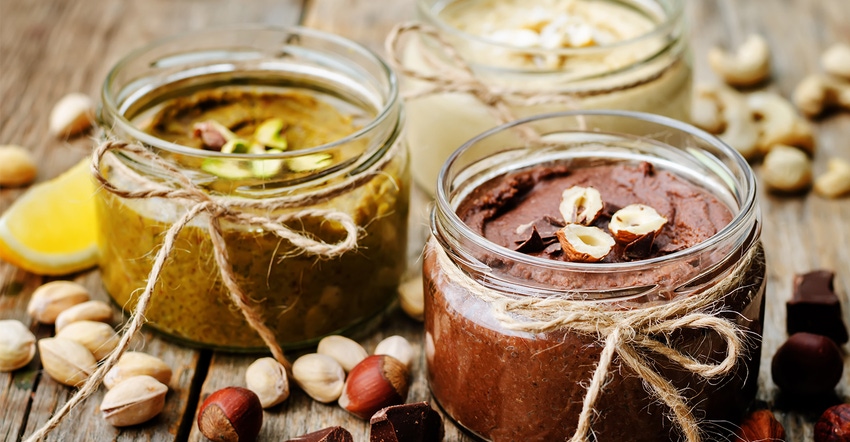Nut butter, sweet spread sector to hit $6.5 billion by 2018
Starting from a simple jar of peanut butter and evolving to the industry game-changer Nutella, a recent boom in the nut-based and sweet spread sector has opened doors to endless opportunities for manufacturers of these spreads, according to the latest market data from Mintel.
April 3, 2014

CHICAGO
Starting from a simple jar of peanut butter and evolving to the industry game-changer Nutella, a recent boom in the nut-based and sweet spread sector has opened doors to endless opportunities for manufacturers of these spreads, according to the latest market data from Mintel.
Peanut butter, the classic pantry staple, has led the way for other nut butters like almond, cashew, macadamia nut, coconut and walnut to enter the industry and offer a wider variety of spreads for consumers. Along the way, indulgent spreads such as Nutella helped today’s $3.9 billion nut-based and sweet spread category grow 34% from 2008 to 2013, according to Mintel. But there is still room for growth, and sales in this category will likely increase 65% from 2013-2018 to hit $6.5 billion in sales by 2018.
The appeal of indulgent spreads like Nutella has influenced several non-spread brands to enter the spreads market as well. These product innovations are in line with consumer interests: one in five consumers wants to see more indulgent nut-based spreads, such as raspberry white chocolate or chocolate chip. In fact, from 2009 to 2013, there was a 97.7% increase in the percentage of new products that represent new varieties or range extensions.
“Brands are introducing chocolate-based spreads, including brands within the category, such as Jif, but also brands outside of the category, like Philadelphia," said Mintel food analyst Amanda Topper. “This is helping to blur the lines between the use of these products as a spread or dip and demonstrating the product’s cross-category appeal."
Topper added that the perception of peanut butter as a “kid’s food" has started to disappear as consumers realize the food's functionality as an ingredient and snack.
Despite the increasing prevalence of peanut allergies in the United States, perception might outweigh the reality: only 1% of children and 0.6% of adults suffer from peanut allergies, according to the National Institutes of Health. In fact, the number of nut or chocolate-based spreads that have non-allergen claims has actually decreased by 30% since 2009. Despite fewer options, about 22% of consumers have purchased non-peanut or almond butters, including cashew butter or sunflower seed butter, within the past six months. Nearly half of consumers (47%) agree peanut-substitute and seed-based spreads also are suitable for those without nut allergies.
While peanut allergies affect only a small portion of consumers, brands can still promote alternative spreads to people looking for healthier options to slather on their snacks. Consumers indicate a preference for spreads made with natural ingredients and without the use of additives or unnecessary sugar or salt, and about 55% wish there were more nut-based and sweet spreads that offered health benefits, such as added vitamins or antioxidants.
In addition, nearly half (47%) prefer spreads with health claims over traditional varieties, and consumers are most interested in seeing more products without additives or preservatives (36%). High-protein claims are important to nut-based spread purchases, while sugar-related attributes, such as no added sugar or no high-fructose corn syrup, are important to those purchasing fruit spreads.
“Essentially, consumers like the idea of a healthier alternative, but at the end of the day, they also enjoy their indulgences," Topper said. “That said, there are certainly ways to achieve both, as Nutella has shown. It’s seen as an indulgence, but one that people can rationalize given it’s claims that it includes no artificial colors or preservatives. Manufacturers of gourmet spreads would be wise to also consider incorporating natural or organic ingredients which, in turn, may also warrant a higher price point."
You May Also Like




.png?width=800&auto=webp&quality=80&disable=upscale)